
Another Demo-1 milestone is complete: The unpressurized trunk section of the SpaceX Crew Dragon separated from the vehicle. The deorbit burn now is only minutes away.

Another Demo-1 milestone is complete: The unpressurized trunk section of the SpaceX Crew Dragon separated from the vehicle. The deorbit burn now is only minutes away.

The uncrewed SpaceX Crew Dragon soon will start its return to Earth. Deorbit burn—a 15-minute, 25-second firing of the spacecraft’s thrusters that will slow the vehicle and begin its descent—is planned to begin at approximately 7:52 a.m. EST. Splashdown in the Atlantic Ocean is expected at about 8:45 a.m. EST.
Earlier this morning, the Crew Dragon departed from the International Space Station, undocking at 2:32 a.m. EST and performing a series of departure burns to move away from the orbiting laboratory, where it spent the past five days. At about 7:48 a.m., Crew Dragon will separate from its trunk containing its solar array and radiator. Its nosecone will close after the deorbit burn prior to atmospheric entry.
The Expedition 58 crew aboard the station, NASA astronaut Anne McClain, David Saint-Jacques of the Canadian Space Agency, and Russian cosmonaut and Expedition 58 commander Oleg Kononenko, loaded about 300 pounds of hardware and science aboard Crew Dragon before closing the hatch Thursday. The spacecraft also is carrying a lifelike test device, Ripley, which is gathering data about what astronauts flying aboard Crew Dragon will experience.
Known as Demo-1, SpaceX’s inaugural mission with NASA’s Commercial Crew Program is an important end-to-end flight test of the new system’s capabilities.

SpaceX’s Crew Dragon spacecraft has exited the “approach ellipsoid,” an imaginary boundary around the International Space Station that governs all vehicles coming or going from the orbiting laboratory.
In about five hours, the Crew Dragon will separate from its trunk whose exterior contains a solar array that provided power to Dragon and a radiator to reject heat.
Crew Dragon’s thrusters will initiate the spacecraft’s deorbit burn at about 7:53 a.m. The 15-minute, 25-second burn will place the Crew Dragon on its final re-entry path into Earth’s atmosphere. The spacecraft is expected to splashdown in the Atlantic Ocean at about 8:45 a.m., its speed slowed by an enhanced parachute system in which drogue parachutes will deploy about four minutes before landing to unfurl four main chutes less than a minute later.
After Crew Dragon lands in the Atlantic Ocean, SpaceX’s recovery ship will recover it and return it to Port Canaveral, Florida, to conclude its mission.

The second of four departure burns has moved the Crew Dragon spacecraft more than 500 meters away from the International Space Station, a distance that will continue to grow.
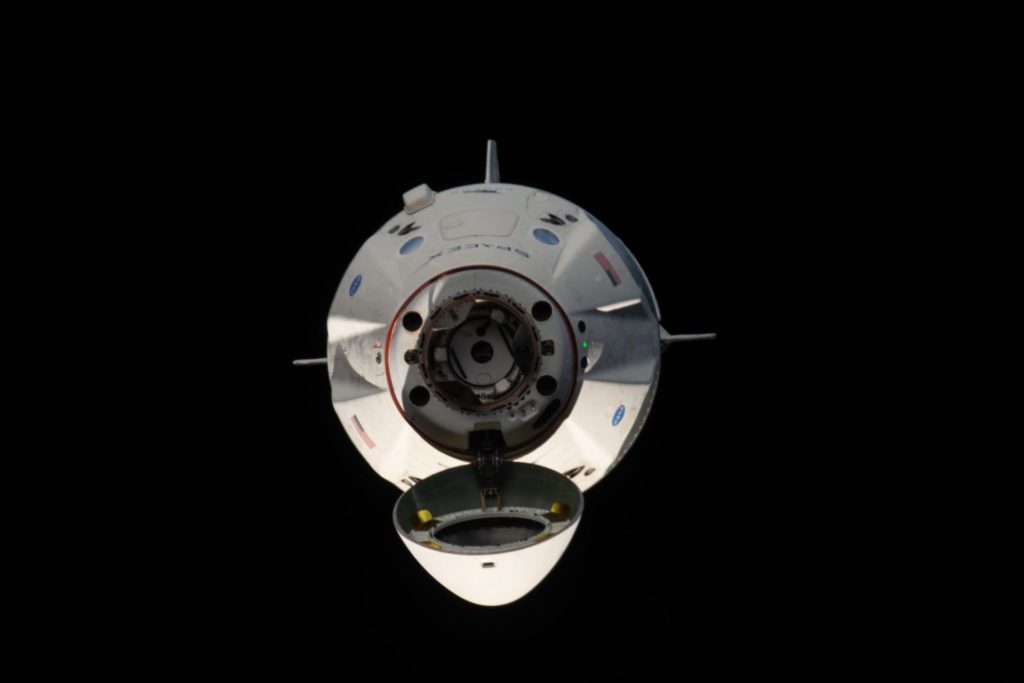
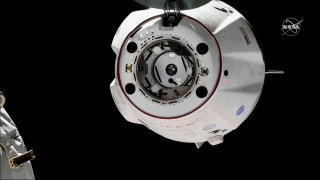 The SpaceX Crew Dragon spacecraft has left the International Space Station. The uncrewed spacecraft undocked from the orbiting laboratory at 2:32 a.m. EST, signaling the beginning of the end of the Demo-1 flight test and the Crew Dragon’s first trip to space.
The SpaceX Crew Dragon spacecraft has left the International Space Station. The uncrewed spacecraft undocked from the orbiting laboratory at 2:32 a.m. EST, signaling the beginning of the end of the Demo-1 flight test and the Crew Dragon’s first trip to space.
Two short firings of the Crew Dragon’s Draco thrusters will move the spacecraft away from the space station. A series of departure burns will increase the distance between the two vehicles. Deorbit burn, which will slow the spacecraft and begin its descent to Earth, is scheduled for approximately 7:53 a.m. EST. Splashdown in the Atlantic Ocean is expected at approximately 8:45 a.m. EST.

The SpaceX Crew Dragon is “go” to undock from the International Space Station. That milestone is expected at approximately 2:31 a.m. EST. The vestibule between the spacecraft and the station has been depressurized in preparation for undocking.

The SpaceX Crew Dragon is set to depart this morning from the International Space Station, capping a successful week in which the uncrewed spacecraft delivered more than 400 pounds of crew supplies and equipment to the orbiting laboratory. The spacecraft is scheduled to undock from the station at approximately 2:31 a.m. EST—about half an hour from now—and return to Earth with a splashdown in the Atlantic Ocean at approximately 8:45 a.m. EST.
The Crew Dragon launched Saturday, March 2, aboard a SpaceX Falcon 9 rocket from Launch Complex 39A at the NASA’s Kennedy Space Center in Florida. In addition to cargo bound for the space station, the spacecraft also has a “passenger”—an anthropomorphic test device outfitted with sensors to collect data about potential effects on humans traveling in Crew Dragon for critical phases like ascent, entry and landing.
The spacecraft has been docked to the space station’s Harmony module since Sunday, March 3. The Expedition 58 crew aboard the station, NASA astronaut Anne McClain, David Saint-Jacques of the Canadian Space Agency, and Russian cosmonaut and Expedition 58 commander Oleg Kononenko, closed the Crew Dragon’s hatch yesterday at 12:39 p.m. EST.
The Demo-1 mission is SpaceX’s first flight with NASA’s Commercial Crew Program. The flight test marks a significant step toward returning to the nation the capability to launch astronauts on a U.S.-built spacecraft from U.S. soil, as well as the potential to expand the station’s capability for microgravity research.
Demo-1 is a precursor to the in-flight abort test that will occur this summer with this same spacecraft in preparation to carry NASA astronauts Bob Behnken and Doug Hurley to the station on the Demo-2 mission, slated for July 2019.
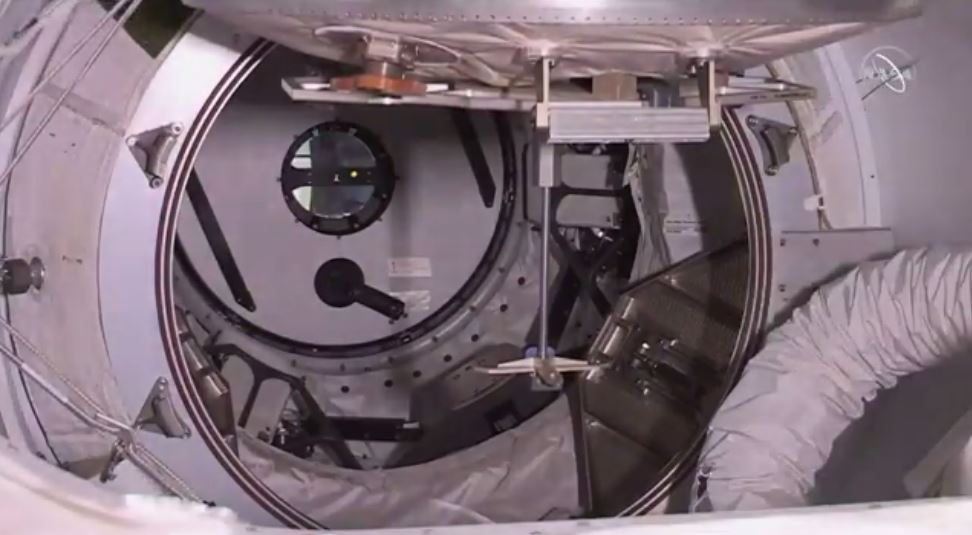
At 12:39 p.m. ET, the Expedition 58 crew aboard the International Space Station closed the hatch between the SpaceX Crew Dragon and the orbital laboratory.
NASA astronaut Anne McClain, David Saint-Jacques of the Canadian Space Agency, and Russian cosmonaut and Expedition 58 commander Oleg Kononenko, gathered briefly inside the Crew Dragon to pose for a round of photos before exiting the spacecraft.
“Dragon hatch closed, 17:39 GMT,” Saint-Jacques reported to the team in the space station flight control room at the agency’s Johnson Space Center in Houston, giving the time in Greenwich Mean Time.
The Crew Dragon’s splashdown in the Atlantic Ocean will complete its five-day uncrewed Demo-1 mission dedicated to testing the company’s end-to-end system designed to return human launches to the International Space Station from the United States as part of NASA’s Commercial Crew Program. On board for the spacecraft’s return is a lifelike, anthropomorphic test device named Ripley, outfitted with sensors to provide data about potential effects on humans traveling in Crew Dragon for critical phases like ascent, entry and landing.
Coverage of the Crew Dragon undocking will begin on NASA Television and the agency’s website at 2 a.m. Friday, March 8, with physical separation of the spacecraft expected at about 2:31 a.m.
Live coverage from SpaceX mission control in Hawthorne and NASA mission control at Johnson Space Center in Houston will resume at 7:30 a.m. for the spacecraft’s deorbit burn scheduled at 7:50 a.m. and continue through Crew Dragon’s anticipated splashdown in the Atlantic Ocean at 8:45 a.m.
More details about the mission and NASA’s commercial crew program can be found in the press kit online and by following the commercial crew blog, @commercial_crew and commercial crew on Facebook.
Learn more about station activities by following @space_station and @ISS_Research on Twitter as well as the ISS Facebook and ISS Instagram accounts.
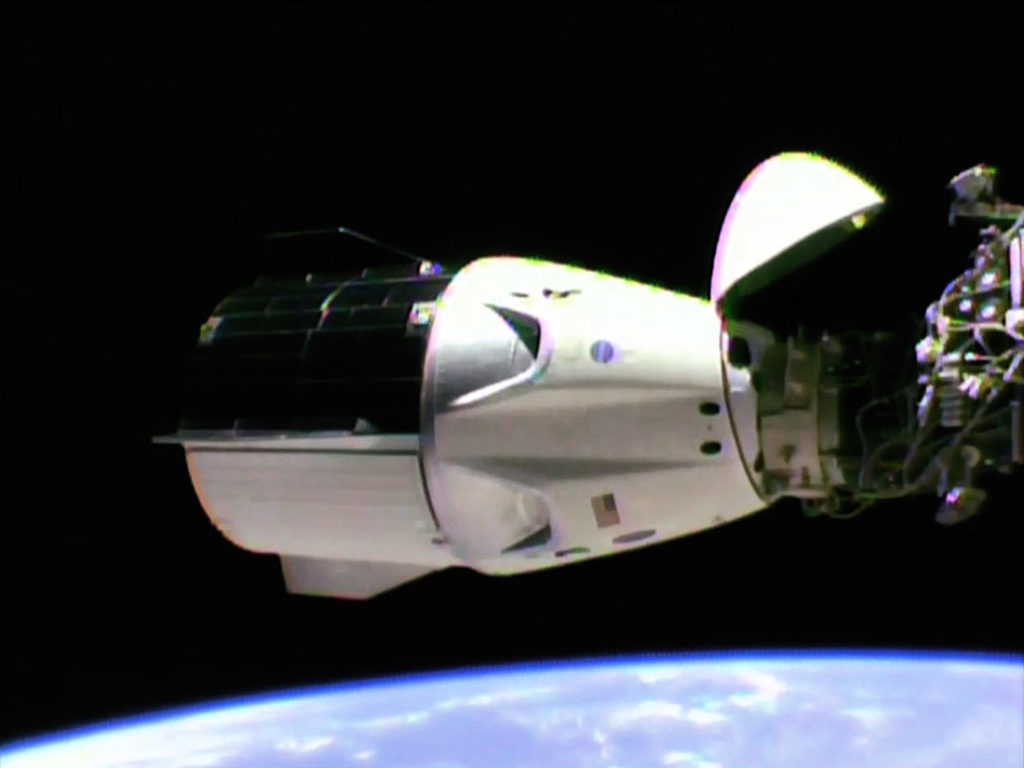
The SpaceX Crew Dragon continues to perform well as the Demo-1 flight test nears completion. The Crew Dragon hatch will be closed today, March 7, at approximately 12:25 p.m. EST. Watch it live beginning at 12:15 p.m. on NASA TV.
Crew Dragon will remain docked to the International Space Station until approximately 2:30 a.m. on Friday, March 8. The spacecraft is expected to return to Earth hours later, with a splashdown in the Atlantic Ocean at approximately 8:45 a.m.
More details about the mission and NASA’s commercial crew program can be found in the press kit online and by following @commercial_crew and commercial crew on Facebook.
Learn more about station activities by following @space_station and @ISS_Research on Twitter as well as the ISS Facebook and ISS Instagram accounts.
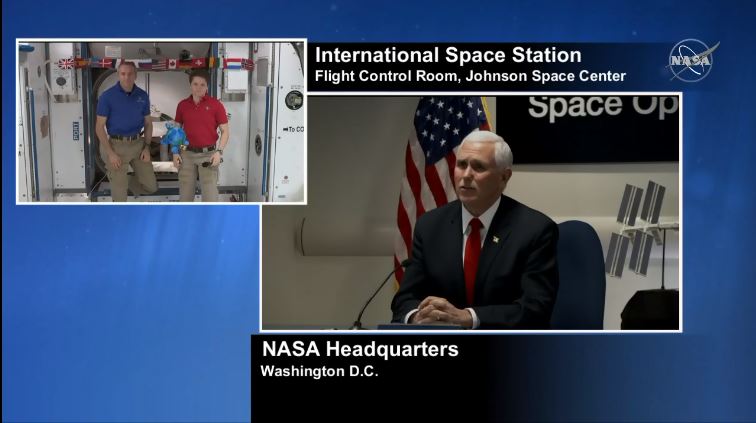
The SpaceX Crew Dragon continues to perform well more than halfway through the Demo-1 flight test. Currently docked to the International Space Station’s Harmony module, the spacecraft is performing an end-to-end demonstration of its capabilities during the company’s first flight with NASA’s Commercial Crew Program.
Vice President Mike Pence provided a boost to the station’s crew with a congratulatory call on Wednesday afternoon.
“It was inspiring to see the launch. It was even more inspiring to see the docking and to see you open that door and float into that spacecraft knowing that we’ll very soon have American astronauts aboard,” Pence said, adding that the Demo-1 mission is evidence of the United States’ renewed commitment to leadership in space.
“Witnessing Dragon docking was a real honor; we feel very privileged to have been a part of it,” NASA astronaut Anne McClain answered. “There’s an intersection of practical and magical. In the back of our mind we knew how significant it was and how important it was for the whole history of spaceflight.”
A SpaceX Falcon 9 rocket boosted the Crew Dragon into orbit with a brilliant predawn liftoff on Saturday, March 2, from Launch Complex 39A at NASA’s Kennedy Space Center in Florida. The spacecraft caught up to the space station on Sunday, March 3, successfully docking to the orbiting laboratory at 5:51 a.m. EST. McClain, David Saint-Jacques of the Canadian Space Agency, and Russian cosmonaut and Expedition 58 commander Oleg Kononenko opened the Crew Dragon’s hatch at 8:07 a.m.
Strapped into one of the spacecraft’s seats is Ripley, a lifelike test device outfitted with sensors to provide important data about what humans traveling on Crew Dragon will experience. The spacecraft also ferried 400 pounds of crew supplies and equipment to the station.
The Crew Dragon hatch will be closed tomorrow afternoon at approximately 12:25 p.m. The spacecraft will remain docked to the space station until approximately 2:30 a.m. on Friday, March 8. The spacecraft is expected to return to Earth hours later, with a splashdown in the Atlantic Ocean at approximately 8:45 a.m. These milestones will be broadcast on NASA TV.
The Demo-1 mission marks a significant step toward returning to the nation the capability to launch astronauts on a U.S.-built spacecraft from U.S. soil, as well as the potential to expand the station’s capability for microgravity research.